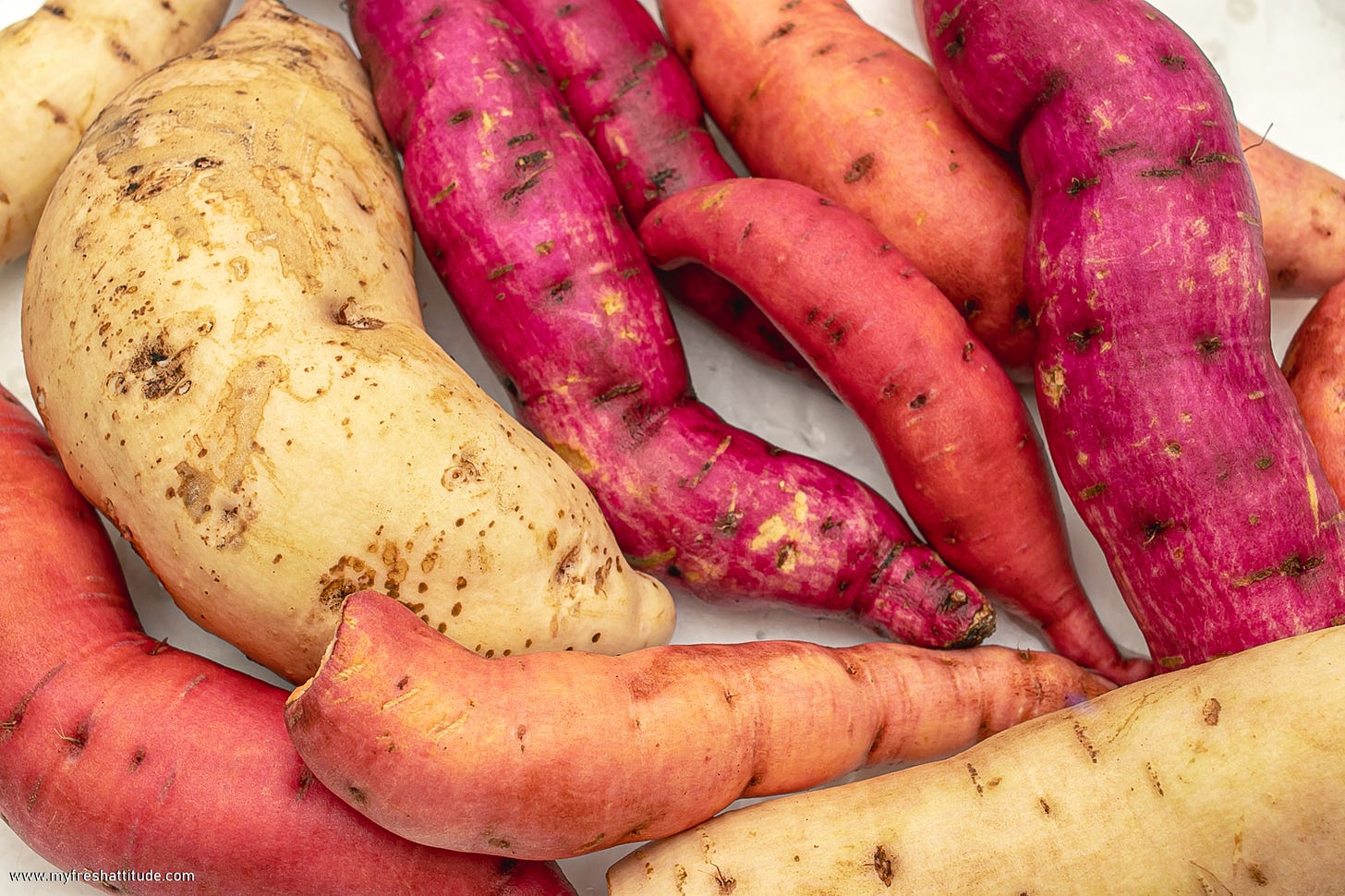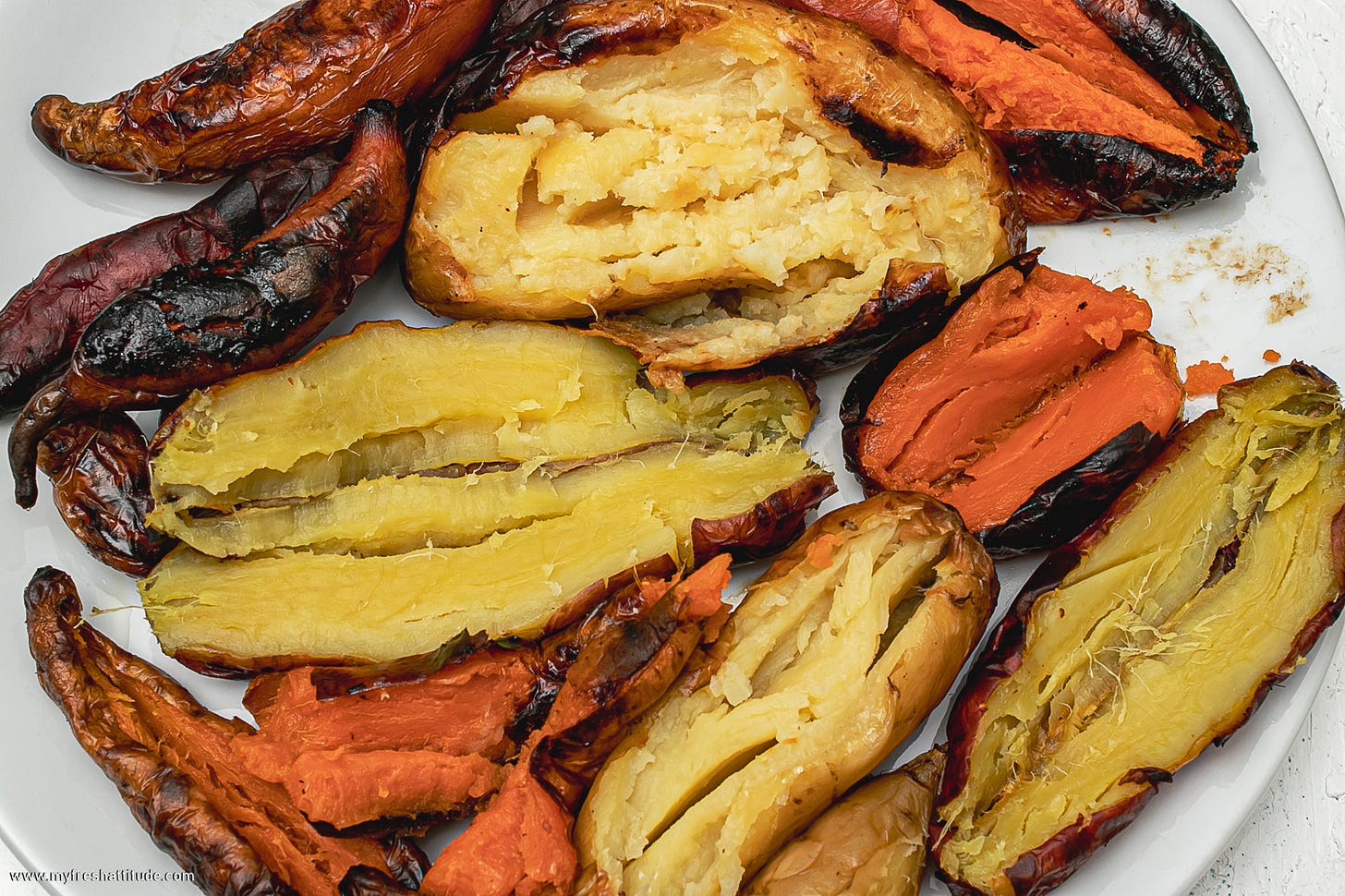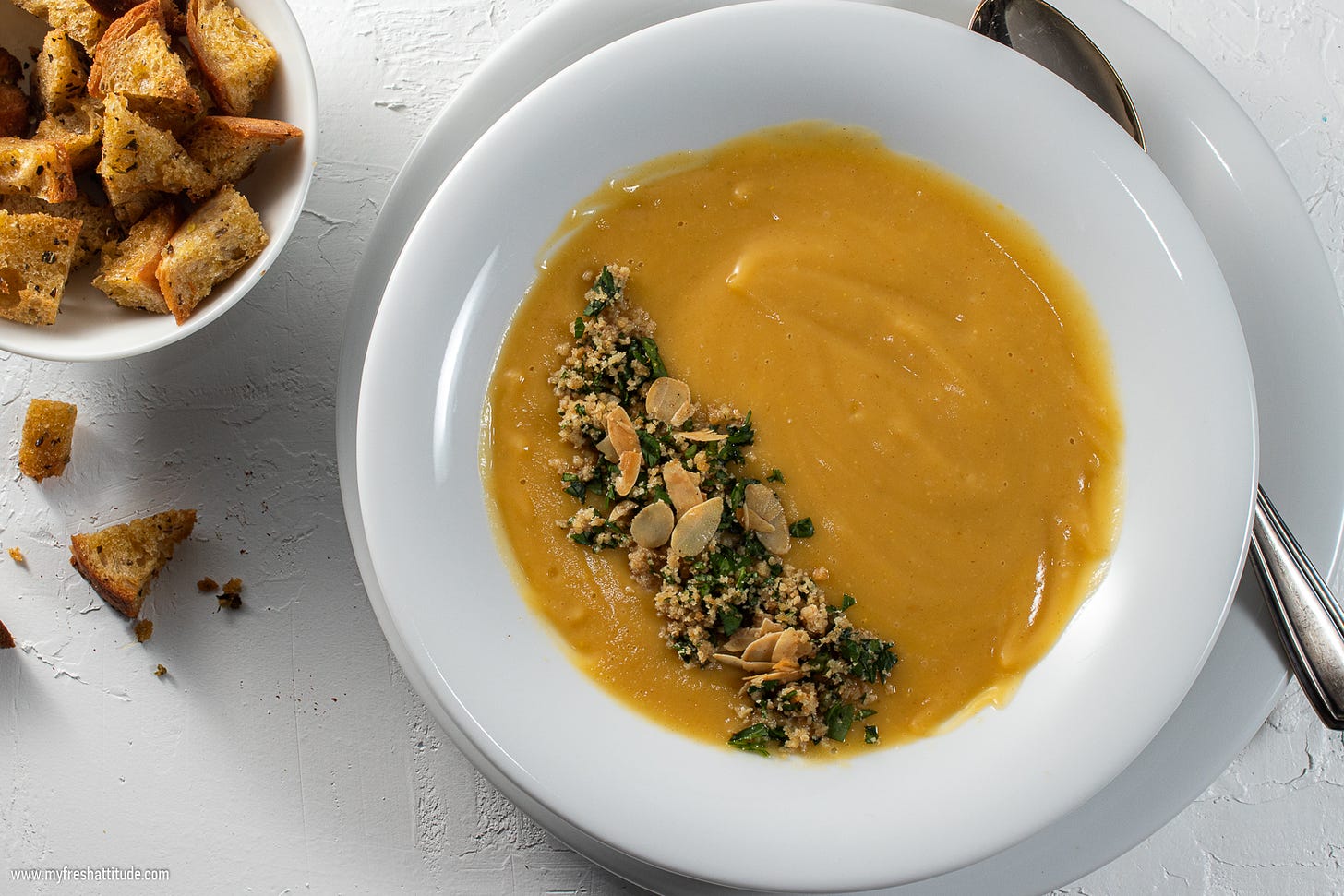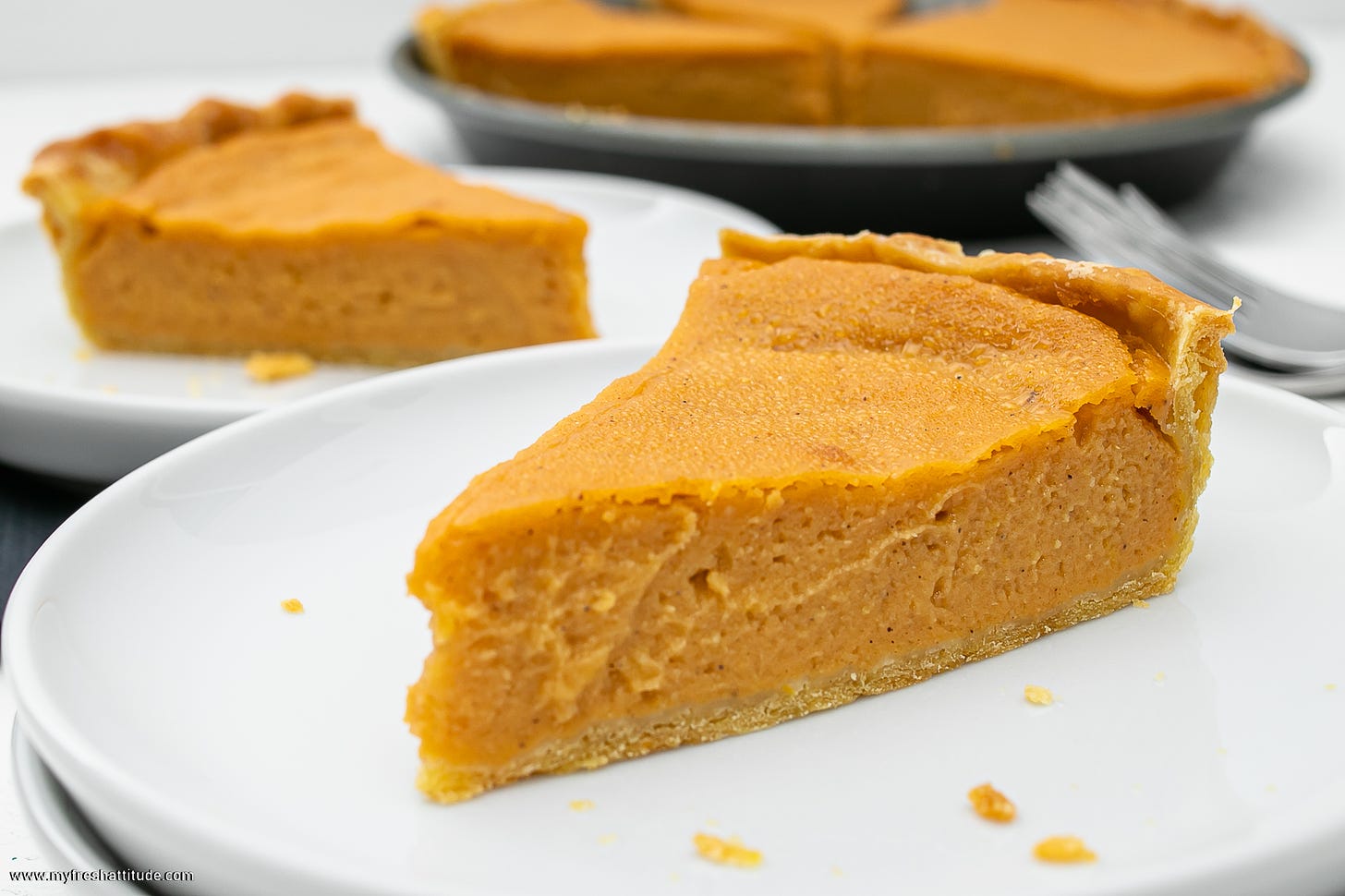I updated this article in November 2023. Please visit the following link to access the latest edition…and the updated recipes…
Sweet potatoes have lived a one-dimensional existence in my head. Sure, I occasionally enjoyed eating a roasted sweet potato, and they were mainly ok – not exceptional or exciting. And when I compared them to pumpkins, sweet potatoes were second-class ingredients and not part of my usual autumn culinary creations.
This year, my power rankings changed dramatically, and sweet potatoes became my fall obsession.
My newly discovered respect for sweet potatoes started when I decided to fill one of my urban garden boxes with a few different varieties of sweet potatoes. I didn’t know what to expect. I wasn’t even sure how the plant would look once it matured. To my delight, it looked a lot like an average house plant – the big green leaves with wiry stems reminded me of ivy...I guess it is not surprising since it is a member of the morning glory family. As the summer months relentlessly moved toward autumn, the plants produced beautiful tubular flowers with purple interiors...a sure sign that the roots below were developing into swollen edible tips. I started to anticipate the first harvest, now only weeks away. And when that day arrived, my hand dug into the earth and confronted a large sweet potato. I couldn’t help smiling and feeling satisfied. I dug up 2 or 3 more sweet potatoes and headed straight to my kitchen with growing anticipation.
My freshly harvested sweet potatoes were delicious. They only required 20 minutes in a hot oven. And I didn’t invest much time, money or energy to produce something tasty and nutritious. Those are bonus points in my go-to ingredient power rankings.
As expected, eating something I grew myself helped me evaluate sweet potatoes from a different perspective. This is precisely what happened when I tasted my first harvest of pumpkins, Swiss chard...or chili peppers. Still, I kept thinking I was missing something about sweet potatoes – something that might help me understand why these vegetables rank among the most important food crops in the world (after rice, wheat, corn and sorghum).
Then, I turned to my favorite food scientist Harold McGee and social media friend and pastry chef extraordinaire Stella Parks to see what they thought about sweet potatoes.
McGee went into great detail about how starches convert to sugars at low cooking temperatures, creating sweet potatoes with a nutty aroma and caramel-like flavor. The key was slow-roasting at a temperature below 160°C (320°F), which allows an enzyme to do its work and turn starch into sugar. High-temperature roasting kills the enzyme before it can complete its task...and that was enough to convince me to try it and taste the results.
I compared different varieties of sweet potatoes, using high and low temperatures for times ranging between 25 minutes and 2 hours. My results were conclusive. The slow-roasted sweet potatoes, regardless of variety, tasted much sweeter than those roasted in a hot oven for a short time.
I was convinced I had found the best way to prepare sweet potatoes. I’m sure the experts agreed that slow-roasting sweet potatoes create the best puree for a pie I’ve always wanted to try making – sweet potato pie. I was wrong. In Stella Park’s article on the Serious Eats website, she argues that an old American method of boiling orange-fleshed sweet potatoes works best – especially if boiled in milk and cream. Her reasoning was simple – the milk and cream created toffee-like notes, and the sweet potato’s flavor remained fresh. I tried it...replacing the milk and cream with soy milk and oat cream. The puree was the best bit of food I’ve put into my mouth this season – I turned into a child who couldn’t get enough of that first taste of sweet hitting the tongue. When I finally made the pie, I concluded there was no reason ever to consider making another pumpkin pie.
Sweet Potatoes are Better Than Pumpkins
Sweet potatoes offer a range of flavors, colors and textures...just like pumpkins. They are abundant and relatively inexpensive...just like pumpkins. They can be cooked in many ways...just like pumpkins. They store reasonably well in cool and dark locations...just like pumpkins.
So why are they better?
For me, it’s all about flavor...and sweet potatoes offer much more flavor than most pumpkins. Try my slow-roasted sweet potato recipe and discover how deliciously rich, creamy and flavorful sweet potatoes are when served with nothing more than a pinch of sea salt. Do the same with a pumpkin, and it will scream, “I need more spice...or fat...or seasoning.” The same is true with my Sweet Potato Pie recipe – there’s no need to layer spice after spice to create flavor; it’s already bursting with toffee and caramel in a perfectly set custard.
Sweet potatoes also produce less food waste than a pumpkin. The shell of most pumpkins needs some trimming. The seeds are generally removed. The yield is typically something like 40% for a pumpkin, compared to a 90-100% yield for sweet potatoes.
I’m not anti-pumpkin. I’ve learned to love them for what they are and created some delicious pumpkin recipes. And my favorite recipes come from Japanese-style kabocha varieties – the ones with a dry, flaky interior when cooked and a flavor that’s very similar to...sweet potatoes.
So, this year I’m all in on sweet potatoes...and I will not be participating in the pumpkin-spiced everything craze. I’m going to keep it simple with sweet potatoes.
Slow-Roasted Sweet Potatoes
This method works with all varieties of sweet potatoes. I like to mix it up and use several different types with varying sweetness and colors if I am serving the potatoes as a side instead of using them for another purpose. This method of cooking sweet potatoes works very well if you are only using the interior to puree. The skins lift away, and the flesh can be worked through a potato ricer (a handy item in any kitchen) to create a fine puree.
Sweet Potato and Jerusalem Artichoke Cream Soup
Jerusalem artichokes – sometimes called sunchokes – have no relation to artichokes and aren’t particularly popular in Jerusalem. And the name is not the end of the mystery surrounding this tuber. Most people have no idea what to do with this strange fall vegetable. That’s too bad because the warm sunflower flavor, accented with a hint of water chestnuts, is intriguing and delicious. Once cooked, Jerusalem artichokes become soft and starchy, making them a perfect ingredient for pureed soups.
I chose sweet potatoes for this recipe to lend a touch of sweetness to balance the earthiness of the Jerusalem artichokes. The chili powder elevates the soup and creates a flavor explosion in the mouth. A few tablespoons of Garlicky Lemon-Walnut Crumble adds texture to the soup and another layer of intense flavor.
This is a simple soup to prepare. It adds uniqueness to any festive table during the year's colder months. It’s also a perfect starting point for newcomers to Jerusalem artichokes.
Sweet Potato Pie
The inspiration for this recipe came from my Twitter friend, Stella Parks, pastry chef extraordinaire and cookbook author. Over the years, I’ve veganized several of her recipes, and I was always impressed with how well her techniques worked to create a successful recipe – even true with my vegan alterations.
Stella’s Sweet Potato Pie recipe is an example of my latest vegan transformation success – and what a grand success too!
It is essential to use the correct sweet potato for this recipe. Any sweet potato with an orange interior works best (for example, try using a Garnet variety). I tried oat milk, rice milk and soy milk for this recipe. Soy milk was the clear winner, producing a purée that appears identical to Stella’s version that uses milk. I relied heavily on my previous work with custards to replace the eggs and decided to keep things simple in this recipe. I used a basic store-bought egg replacer containing only starch, then added 2 additional tablespoons of corn starch. Of course, using a damn good vegan pastry that is properly pre-baked helps to improve the probability of success.
Special Equipment: Use a 23 cm (9 inch) round pie pan. Using an immersion blender to create the purée helps make a silky-smooth puree – all in one pan or pot.
Make Ahead Note: The custard can be made several days in advance. Keep it refrigerated until ready to use. Pour directly into the prepared pie crust or gently heat until smooth and pliable to create a soft top.
Share Your Thoughts…
I always appreciate hearing from my readers, so feel free to comment and let me know what’s on your mind.
What’s your position – do you prefer sweet potatoes over pumpkins (winter squash)?
Share as much or as little as you want…
There are lots of ways to join the conversation and offer your thoughts. Jump onto Substack Notes and comment or restack this article (or even a portion)…or hit the button below and leave a comment at the bottom of this article.
Social Media
Catch up with me on social media…
Facebook ¦ Instagram ¦ LinkedIn ¦







I'm late to this sweet potato party, but excited to try these recipes (and the gnocchi)! I'm intrigued by the slow roasting process, as I'm usually a 425 for 45 minutes kinda gal. The Honey (RA in your comments section) is usually the pie guy, because I'm not really a baker (so much exact measuring!). So, I might turn the sweet potato pie making into a family affair ! :)
Sweet potatoes are plentiful here, and I am looking forward to trying that pie! I’ll try that soup, too, if I can find Jerusalem artichokes.